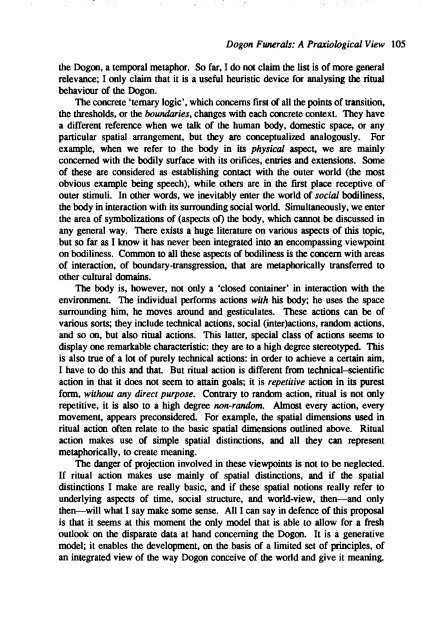1991 No. 1 CONTENTS - Institute of Social and Cultural ...
1991 No. 1 CONTENTS - Institute of Social and Cultural ...
1991 No. 1 CONTENTS - Institute of Social and Cultural ...
Create successful ePaper yourself
Turn your PDF publications into a flip-book with our unique Google optimized e-Paper software.
Dogon Funerals: A Praxiological View 105<br />
the Dogon, a temporal metaphor. So far, I do not claim the list is <strong>of</strong> more general<br />
relevance; I only claim that it is a useful heuristic device for analysing the ritual<br />
behaviour <strong>of</strong> the Dogon.<br />
The concrete 'temary logic', which concerns fast <strong>of</strong> all the points <strong>of</strong> transition,<br />
the thresholds, or the boundaries, changes with each concrete context. They have<br />
a different reference when we talk <strong>of</strong> the human body, domestic space, or any<br />
particular spatial arrangement, but they are conceptualized analogously. For<br />
example, when we refer to the body in its physical aspect, we are mainly<br />
concerned with the bodily surface with its orifices, entries <strong>and</strong> extensions. Some<br />
<strong>of</strong> these are considered as establishing contact with the outer world (the most<br />
obvious example being speech), while others are in the fast place receptive <strong>of</strong><br />
outer stimuli. In other words, we inevitably eriter the world <strong>of</strong> social bodiliness,<br />
the body in interaction with its surrounding social world. Simultaneously, we enter<br />
the area <strong>of</strong> symbolizations <strong>of</strong> (aspects <strong>of</strong>) the body, which cannot be discussed in<br />
any general way. There exists a huge literature on various aspects <strong>of</strong> this topic,<br />
but so far as I know it has never been integrated into an encompassing viewpoint<br />
on bodiliness. Common to all these aspects <strong>of</strong> bodiliness is the concern with areas<br />
<strong>of</strong> interaction, <strong>of</strong> boundary·transgression, that are metaphorically transferred to<br />
other cultural domains.<br />
The body is, however, not only a 'closed container' in interaction with the<br />
environment. The individual perfonns actions with his body; he uses the space<br />
surrounding him, he moves around <strong>and</strong> gesticulates. These actions can be <strong>of</strong><br />
various sorts; they include technical actions, social (inter)actions, r<strong>and</strong>om actions,<br />
<strong>and</strong> so on, but also ritual actions. This latter, special class <strong>of</strong> actions seems to<br />
display one remarkable characteristic: they are to a high degree stereotyped. This<br />
is also true <strong>of</strong> a lot <strong>of</strong> purely technical actions: in order to achieve a certain aim,<br />
I have to do this <strong>and</strong> that. But ritual action is different from technical-scientific<br />
action in that it does not seem to attain goals; it is repetitive action in its purest<br />
fonn, without any direct purpose. Contrary to r<strong>and</strong>om action, ritual is not only<br />
repetitive, it is also to a high degree non·r<strong>and</strong>om. Almost every action, every<br />
movement, appears preconsidered. For example, the spatial dimensions used in<br />
ritual action <strong>of</strong>ten relate to the basic spatial dimensions outlined above. Ritual<br />
action makes use <strong>of</strong> simple spatial distinctions, <strong>and</strong> all they can represent<br />
metaphorically, to create meaning.<br />
The danger <strong>of</strong> projection involved in these viewpoints is not to be neglected.<br />
If ritual action makes use mainly <strong>of</strong> spatial distinctions, <strong>and</strong> if the spatial<br />
distinctions I make are really basic, <strong>and</strong> if these spatial notions really refer to<br />
underlying aspects <strong>of</strong> time, social structure, <strong>and</strong> world·view, then-<strong>and</strong> only<br />
then-will what I say make some sense. All I can say in defence <strong>of</strong> this proposal<br />
is that it seems at this moment the only model that is able to allow for a fresh<br />
outlook on the disparate data at h<strong>and</strong> concerning the Dogon. It is a generative<br />
model; it enables the development, on the basis <strong>of</strong> a limited set <strong>of</strong> principles, <strong>of</strong><br />
an integrated view <strong>of</strong> the way Dogon conceive <strong>of</strong> the world <strong>and</strong> give it meaning.
















